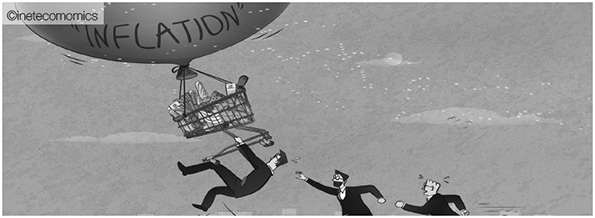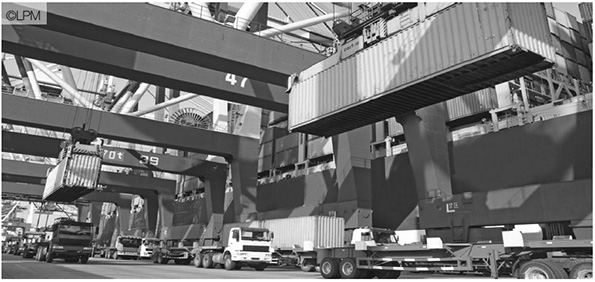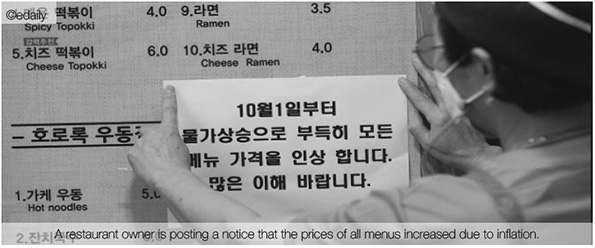Extravagant consumption trends like YOLO (;You only live once) or Flex (; showing off luxuries and wealth) had been popular in the media a few years ago. However, in contrast to those trends, saving trends like the non-consumption challenge is under the spotlight in the media lately. The non-consumption challenge is a kind of extreme saving trend, which literally means the challenge to live a few days or weeks without any consumption. People who jump into this challenge manage to minimize their consumption in various ways like riding a bike to work or getting coupons by using mobile rewarding applications. In particular, those people make a great effort to reduce their food expenses. They changed their routines packing their lunch boxes and having instant coffee or snacks in the staff lounge rather than going out to restaurants and cafes as usual. Why did those people end up hesitating to spend money even at lunch time? The reason is the “remarkable inflation of lunch fees.” The recent rapid inflation surge, which impacted the lunch table, puts excessive strain on workers and college students who need to eat out for lunch. These horrific realities created the new slang Lunchflation which is a combination of lunch and inflation.
Through the statistics, it shows how much the lunch prices rate has soared to the point that it was dubbed Lunchflation. The restaurant dish price index in July 2022 has increased to 111.39, up 7 % over the previous year, according to Statistics Korea. It recorded the largest increase in 29 years and 9 months since Oct. 1992. Moreover, the price per individual food items has been hiked up more sharply. Average prices of bibimbap in Chungcheongbuk-do in Aug. have soared to 8,471 KRW, 13.8% over the last year, according to the Korea Consumer Agency. The price of samgyetang has also jumped up to 16.1% in the same period, and here are a few more examples of prices that has risen measurably compared to the previous year: kalguksu (7,286 KRW, 14.6%), kimbap (2,500 KRW,12.9%), samgyeopsal (13,857 KRW, 11.4%), jajangmyeon (5,857 KRW, 10.8%), naengmyeon (8,286 KRW, 9.4%).

Lee Seong-hyun, who works in Seoul, was shocked by lunch prices increasing day by day. He said “I was really shocked by the breathtaking lunch prices. The price of gukbap, which is a cheap and satisfying meal, also jumped up to even 9,000 KRW to 10,000 KRW. I haven’t been working much so I feel more burdened. Luckily, the company has a cafeteria, which takes off a bit of the pressure.” He is not the only one who felt this economic pressure. According to a survey on ‘How much lunch menu prices pressure workers felt,’ conducted by Incruit in May 2022, 95.5% of the survey participants replied that they felt burdened by lunch menu prices. Furthermore, those who felt the extreme burden were even 56%.
Due to Lunchflation, workers and college students have rushed into convenience stores and cafeterias as alternatives. As doshirak has been a popular lunch menu for workers, doshirak sales near the offices in June 2022 have increased by over 27.1% over the last year, according to the convenience store CU. Sales of samgak gimbap (28.0%), gimbap (23.7%) and Sandwiches (19.3%) have increased remarkably as well. The rate of using cafeterias has also increased. A survey about “Where did the workers have lunch” by Media real research Korea suggests that there’s a narrow gap between “Instant food or the convenience store (31.6%)” and “cafeterias (27.2%).”
This new trend, where people are forced to revert to instant food, is getting restaurant owners in trouble. Lee Yu-hwan, who runs restaurants in Anyang, has been stressed out heavily because of the soaring prices of food materials. He said “The recent prices of food materials don’t make sense at all. The price of vegetables, which has risen enormously, got me thinking that some side menus using vegetables should be pulled out. I guessed the restaurant would be packed after the social distancing was relaxed, but customers didn’t show up due to Lunchflation.”

Readers could discover the reason for skyrocketing inflation from factors on the supply side and factors on the demand side. Park Jong-wook, assistant professor from the Dept. of Economics in CBNU suggests Russia’s invasion of Ukraine and the global supply chain crisis as the supply side factors. He said “Russia, the third largest oil-producing country in the world, has halted oil production and exports due to the invasion of Ukraine. It is forcing up oil prices accordingly. Furthermore, a raw material shortage has accelerated inflation even though South-East Asian countries, the world’s largest manufacturing base, have loosened the regulations on COVID-19. Other supply side factors, like the agricultural price surge sparked from climate change and rising labor cost due to staffing shortages, are leading to inflation as well. As for the demand supply factors, it can be described to the potential demand that rapidly rebounded as social distancing has been loosened. Recent inflation is a mixed result of these factors.”

He warned that inflation might be totally out of control if this current high inflation rate continues. He said “A long-lasting inflation puts the burden on a household’s living cost and it would be a tough obstacle for the economic recovery. Even worse, if the high inflation rate doesn’t moderate, the laborers might claim more wages in response to soaring expected inflation and then this wage growth would cause the supply side factor for inflation. It is called ‘Wage-price spiral’ and if this vicious cycle keeps spinning, inflation could be out of control. That is why a long-term inflation surge could lead us into disaster.”
Inflation must be eased to cut this cycle off, but the remedy’s not simple at all. Park said “Inflation caused by supply side factors, like the oil price surge and global supply chain crisis, is fundamentally based on international factors, so that only one country can hardly resolve the problem by themselves.”
Also, he does not consider the monetary and financial policies to be saviors for inflation moderation. He said “Contractionary fiscal policy, reducing government expenditure, would be conducted but the process of compilation and execution of the government’s budget has been determined not only by economic factors but also political factors and they materialize much slower than the economic experts wished. Moreover, there is a limit to the reduction of aggregate demand by means of cuts in government expenditure, which accounts for less than 20% of total demand. Regulations on public utility charges, another financial policy, have limitations that could distort market function and result in rising levels of public debt. Another option, a tight monetary policy accompanied by an interest rate hike, may decrease demands and somewhat moderate inflation but there are fatal side effects like real estate market contraction and household debt burden.

The government stated that the review of the supply and demand for groceries is conducted every week and concentrates all their efforts to suppress inflation and stabilize food prices. The ruling party and the opposition party compromised and revised the law regarding tax-exemption for meal allowance pushing it up to 200,000 KRW, 100% up from the former allowance.
However, these solutions are not enough to control the increasing Lunchflation. The seriousness of Lunchflation could be felt not only in terms of perceptions but also in the statistics. The people are suffering from inflation while their wages remain the same. Prof. Park said “We can’t deny the fact that it is not easy to ease high inflation but we should deal with it with the best policy based on the circumstances, not giving up and letting it go.” The Lunchflation problem, which is a critical issue directly influencing people’s lives, warrants more active discussions, policies and actions.
By Shim Yun-seop | sys091109@chungbuk.ac.kr
By Ji Jae-lim | jlim0714@chungbuk.ac.kr


 All
All Society & Global
Society & Global






 Shim Yun-seop&Ji Jae-lim
Shim Yun-seop&Ji Jae-lim











